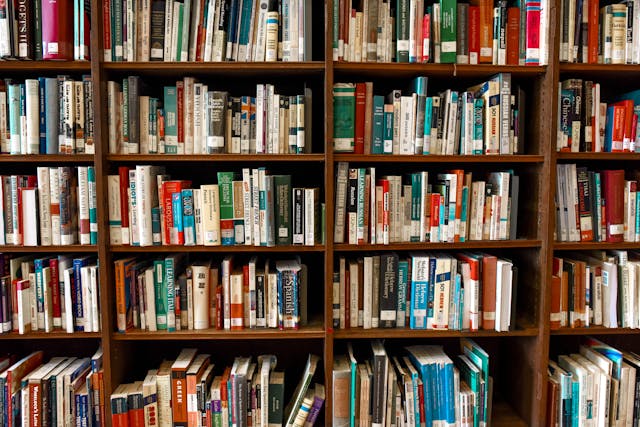
What is the Dewey Decimal system? It is a system used to classify books in libraries, so that they can be found easily. It was created by Melvil Dewey in 1876.
Libraries have existed since writing was first invented. Whatever was written needed a place to be kept in. However, libraries were not public. Clay tablets were written on, baked in a kiln, and then stacked with a note on the side so they could be found later. Libraries became more common as writing spread and as people started to write on papyrus instead of clay. Papyrus is far easier to store space wise, but it doesn’t last as long as clay does. Libraries continued to grow, and the most famous, of course, was the Library of Alexandria. It is said to have housed almost half a million scrolls, but there is no actual evidence for that. It was the center of knowledge and learning, but it wasn’t technically a public library because it wasn’t open to anybody. Ignoring the fact that the majority of people couldn’t read, only certain people were allowed access to the library. These were wealthy people and scholars. Scholars were usually supported by wealthy patrons, so you basically needed money to access the library. And, as travel was expensive and slow, you needed to be able to travel and not work.
There were so many scrolls in the library that finding the one you wanted would be impossible without a system of organization. In roughly 230 BC, a poet called Callimachus was working at the Library of Alexandria and he created the pinakes, which means “tables” in Greek. It was a categorized list of all the scrolls, divided up by genre, and then subdivided. The number of scrolls was constantly growing and the book always needed to be added to. By the end of Callimachus’s life, it had reached 120 books. The pinakes itself doesn’t survive, but there are a lot of references to it in other works to be sure that it existed. This system of organization is basically what the Dewey Decimal system is, but it goes much further.
Two things rapidly increased the number of books in circulation. The first was the invention of the movable type printing press by Johannes Gutenberg in 1440. This made it much easier and faster to print multiple copies of the same book. The second thing was the increasing number of paper mills throughout Europe in the 14th century. Now, the number of paper mills probably increased because of the printing press. Then, in the 19th century, something called the fourdrinier machine was invented, which automated paper making and made it much cheaper. This led to a rapid increase in the number of books that a library could hold. The problem with a system like Callimachus’s pinakes was that you needed to rewrite it if you added books to the library. With more and more books, a system where you could easily add books was necessary.
Library organization had been evolving over time. Sir Francis Bacon had come up with a system that divided books his books into three categories: history, poetry, and philosophy. He then subdivided them into smaller categories within those categories. It was such a good system that American president Thomas Jefferson based the category system for his private library on it. Jefferson used history, philosophy, and fine arts as his categories.
Melvil Dewey was born in 1851 and he started work at Amherst College Library in the 1870s. He decided to try and come up with an improved system of book categorization that would make the books easy to find and easy to put on the shelves. He came up with a decimal system that would allow books to be added very simply. His system starts with the category of the book. He used 9 categories and gave each one a three digit number. These were: 000 – Computer science, information and general works, 100 – Philosophy and psychology, 200 – Religion, 300 – Social sciences, 400 – Language, 500 – Pure science, 600 – Technology, 700 – Arts and recreation, 800 – Literature, and 900 – History and geography. Within each category are other categories as well. For example, 300- social sciences, has 310- statistics, 320-political sciences. And inside political science, you have 321- systems of government, 322- relation of state to organized groups, 323- civil and political rights, and so on. The library is organized in numerical order. So, 323 would come after 322. That makes books very easy to find and organize. After the first three digit number that outlines the category, there is a decimal point and then another number. This number after the decimal point allows for subcategories with the main category.
Let’s look at an example. Guns, Germs, and Steel by Jared Diamond. It is a social sciences book, so it is in the 300s. It is listed as 303, which is social processes. Then it has a number after the decimal point, which is .4. That is social change. Then it has a 21 for the edition number. So, it is 303.4 21.
This is a great system and can be organized using cards. That way you can easily add more books without having to reprint the whole list. And, since it went digital in 1993, it makes it very useful. The only problem with the Dewey Decimal system is that it is Englishcentric, and its categories are outdated, culturally biased, and sometimes racist and discriminatory. They are also subjective. The Dewey classification for a new book is decided by the classification specialists at the Dewey editorial office. And this is what I learned today.
Sources
https://en.wikipedia.org/wiki/History_of_libraries
https://en.wikipedia.org/wiki/Library_of_Alexandria
https://en.wikipedia.org/wiki/Callimachus
https://en.wikipedia.org/wiki/Dewey_Decimal_Classification
https://en.wikipedia.org/wiki/List_of_Dewey_Decimal_classes
https://en.wikipedia.org/wiki/Melvil_Dewey
https://www.loc.gov/exhibits/thomas-jeffersons-library
https://www.librarything.com/mds/303.42
https://en.wikipedia.org/wiki/Guns,_Germs,_and_Steel
Photo by Element5 Digital: https://www.pexels.com/photo/assorted-books-on-book-shelves-1370295/
